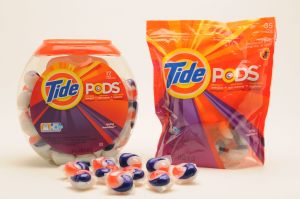 Earlier this week, Pediatrics magazine reported that injuries caused by laundry detergent pods sent an average of one child a day to the hospital in 2012 and 2013. The maker of Tide Pods and the leader in the product category, Procter & Gamble (P&G), is at the forefront of the product design controversy.
Earlier this week, Pediatrics magazine reported that injuries caused by laundry detergent pods sent an average of one child a day to the hospital in 2012 and 2013. The maker of Tide Pods and the leader in the product category, Procter & Gamble (P&G), is at the forefront of the product design controversy.
This report and the resulting media coverage struck a chord with me because I use Tide Pods and am the mother of two young children. Fortunately, my children are older (ages 5 and 8) and rarely put foreign objects in their mouths these days, but I can empathize with parents whose toddlers have mistaken the pods for candy. With leftover Halloween candy still present in my own house, I do see the eerie resemblance between the pods and the gooey eyeball candy my son got trick or treating.
After looking into this issue further, I found that more than 17,000 children were adversely exposed to the laundry pods since P&G spent $150 million to launch the new line in 2011. I also uncovered a tragic story in Chicago where a 15-month-old boy ingested a Tide Pod and nearly died. The child’s grandmother started a petition (securing 33,000 signatures to date) to encourage P&G to change its product design.
As a PR professional, I’m surprised that P&G has not yet addressed the recent report or the growing concern with its product design. I found reports from 2013 stating the company tightened the container closures and added poison signs on its packaging. Despite the improvements, there are still two critical problems: The first is that the pods still resemble candy to a toddler; the second is that the product is not always securely kept in the latched container. The portability of the pods is what appeals to many consumers but that also increases the risk. Many people transport these pods to the Laundromat, a washing machine in another part of the house or when traveling on vacation.
The company received push back on their redesign of Pampers diapers several years ago and they certainly know how to harness the power of moms. Given this, the silence is surprising.
It’s been reported this week that the P&G passed press inquiries to a trade group, the American Cleaning Institute, to address the industry’s efforts. I don’t believe this approach will resonate with the product’s key target, busy moms — especially given the number of children who have been injured by ingesting the product.
While I commend P&G for simplifying an everyday chore with their product design, I believe they shouldn’t ignore negative feedback from a powerful user group. The USA Today article on the issue has a few hundred comments, several suggesting that the onus is on the parent. While I understand this viewpoint, I also think the current design needs to be reexamined. As Jonathan Salem Baskin suggests in his recent piece in Forbes, we wouldn’t design rat poison to look like bubble gum – so why not change the design of a potent laundry detergent?
What do you think about P&G’s public stance (or lack thereof) on this? Did you or will you sign the petition to encourage P&G to change its product design?
